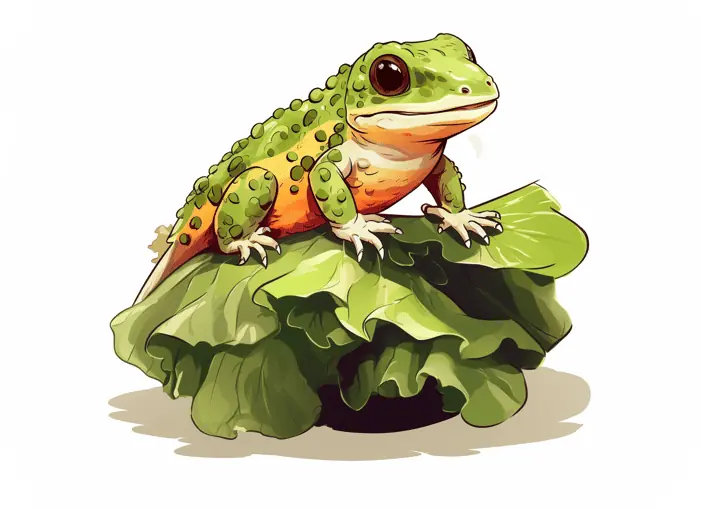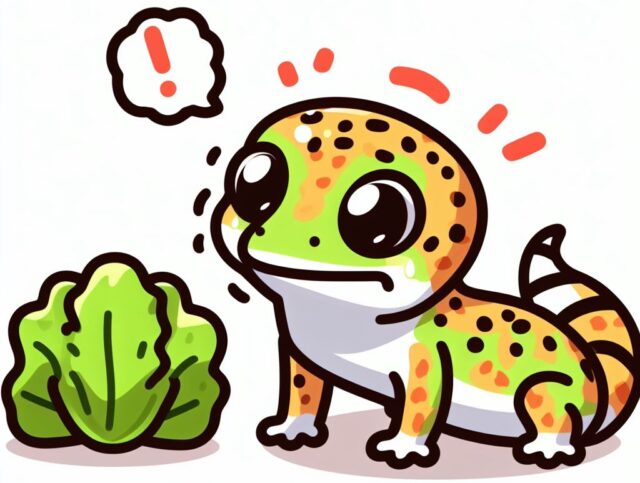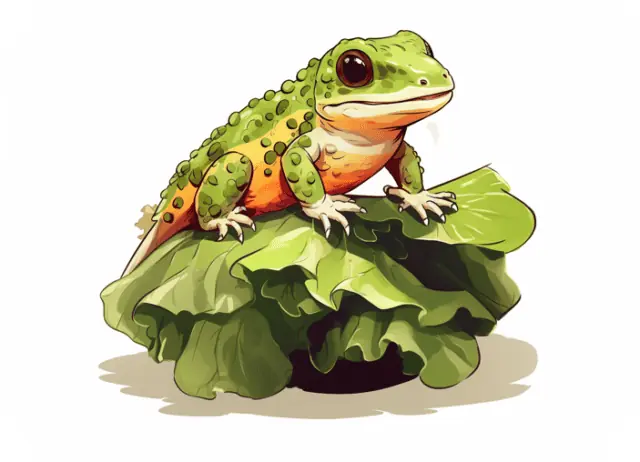Leopard Geckos can’t eat lettuce, because they are insectivores. This means their primary diet consists of insects, and their bodies are not designed to digest plant matter like lettuce. While it might be tempting to offer your gecko a fresh piece of lettuce, thinking it’s a healthy treat, it’s actually not suitable for their dietary needs.
Digestive Differences: Leopard geckos are insectivores with a digestive system not designed for plant matter. They lack a functioning cecum and have an alkaline gut, making lettuce and similar vegetables difficult to digest.
Physical Limitations: Their sharp teeth are tailored for dissecting meat, not grinding vegetables. Plus, their small jaws can’t handle the rigorous chewing needed for lettuce.
Taste Preferences: Lettuce doesn’t sit well on a leopard gecko’s palate. Consuming it can even lead to vomiting due to its unpleasant taste for them.
Nutritional Mismatch: Lettuce lacks essential nutrients crucial for a leopard gecko’s health and growth. These reptiles need a diet rich in certain nutrients, which lettuce doesn’t provide.
Safe Food Options: While no vegetables are suitable for leopard geckos, they thrive on a diet of insects, which are their primary source of vital nutrients.
Why Can’t Leopard Geckos Eat Lettuce?
Every animal has a unique digestive system tailored to the kind of food it naturally consumes. For leopard geckos, their diet revolves around insects, and their bodies have adapted over time to best process these critters. Lettuce and other vegetables are not part of their natural diet, and here’s why.
Their Digestive System Isn’t Designed For It
Leopard geckos, like many reptiles, have a digestive system tailored for specific dietary requirements. In the case of the leopard gecko, their digestive system is optimized to break down and process insects, not plant matter such as lettuce.
A significant reason for this is the absence of a functioning cecum in their digestive tract. The cecum is an essential part of the digestive system in herbivores and omnivores, as it helps in breaking down cellulose found in plant matter. This process requires particular enzymes and microorganisms which the leopard gecko’s digestive system lacks. Without a functioning cecum, the cellulose in lettuce remains largely undigested, which can lead to digestive problems for the gecko.
Furthermore, the leopard gecko’s digestive system is of an alkaline nature. This alkaline gut environment is not conducive for digesting vegetables, including lettuce. In herbivores, the gut is typically more acidic, which aids in breaking down plant fibers.
Table: Digestive Features of the Leopard Gecko
| Feature | Description |
|---|---|
| Digestive System Specialization | Adapted for insects |
| Cecum | Absent (Cannot digest cellulose efficiently) |
| Gut pH | Alkaline (Not suitable for breaking down plant fibers like lettuce) |
Alkaline Gut
The concept of an alkaline gut refers to the pH level of the digestive system. In the case of leopard geckos, their digestive tract tends to be more alkaline than that of herbivores. This alkaline environment is perfect for digesting their natural diet of insects, but it presents challenges when it comes to plant matter, such as lettuce.
Vegetables, like lettuce, contain cellulose, a complex carbohydrate that requires specific enzymes, notably cellulase, for proper digestion. The alkaline conditions of a leopard gecko’s gut hinder the growth of cellulase-producing microorganisms, making it difficult for them to break down cellulose effectively. This inability to produce cellulase means that leopard geckos cannot extract nutrients from plant matter efficiently.
Table: Alkaline Gut in Leopard Geckos
| Aspect | Details |
|---|---|
| Gut pH Level | Alkaline |
| Primary Diet | Insects |
| Effect on Vegetable Digestion | Inefficient due to lack of cellulase-producing microorganisms |
| Cellulose Digestion | Limited, leading to potential digestive complications if consumed. |
Teeth & Jaws
Leopard geckos, like other predators, have evolved with specific physical attributes that support their natural feeding habits. A clear example of this specialization can be observed in their teeth and jaws.
Leopard geckos possess sharp teeth, perfectly designed for dissecting the meats of their insect prey. These teeth are not meant for grinding plant matter like lettuce but rather for puncturing and tearing the exoskeletons of insects. When you think of herbivores that consume plants, their teeth tend to be flatter and broader, suitable for grinding down tough fibers in vegetables. But leopard geckos have a set of pearly whites that are all about the hunt, making short work of crickets, mealworms, and other tasty critters.
In addition to their sharp teeth, leopard geckos have small jaws. These jaws are adept at handling their usual insect diet but are not robust enough for the rigorous chewing required to break down lettuce and other plant materials.
Table: Teeth and Jaw Features of Leopard Geckos
| Feature | Description |
|---|---|
| Teeth Type | Sharp, designed for dissecting meat |
| Jaw Size | Small |
| Dietary Role | Puncturing and tearing insect prey, not grinding plant matter |
They Lack Gizzards
Another fascinating aspect of leopard gecko anatomy that directly affects their diet is the absence of gizzards. Gizzards are specialized digestive organs found in some reptiles, as well as birds, that play a crucial role in breaking down food. These organs contain small stones or pebbles, known as gastroliths, which aid in grinding and processing food.
Now, why is the presence or absence of a gizzard important for a leopard gecko’s diet? Well, the gizzard acts as a natural food processor, especially for animals that consume harder, fibrous foods like plants. It uses the gastroliths to grind down food, making it easier to digest.
Leopard geckos, however, do not have gizzards. This absence means that they lack the built-in machinery to grind and process tougher plant matter efficiently. Their digestive system is streamlined for their insect diet, making them ill-equipped to handle foods that require grinding, like vegetables.
Table: Gizzard and Its Role in Digestion
| Feature | Description |
|---|---|
| Presence in Birds | Helps in grinding seeds, grains, and sometimes small pebbles to aid digestion |
| Gastroliths | Small stones used to break down food in the gizzard |
| In Leopard Geckos | No gizzard present, making it challenging to process fibrous plant matter |
They Prefer Prey That They Can Chase
When observing a leopard gecko in its natural habitat or even in captivity, one quickly notices its keen interest in moving creatures. Leopard geckos have a strong preference for prey that they can chase, and there are several reasons for this behavior:
Stimulating Hunt: The act of chasing prey stimulates the gecko’s predatory instincts, making the hunt more engaging and fulfilling. This not only provides mental stimulation but also physical activity, keeping the gecko active and healthy.
Opportunistic Predators: Leopard geckos are opportunistic predators. This means they’ll seize any chance to catch prey that presents itself. The unpredictable movements and mannerisms of live insects like crickets or mealworms entice the gecko, triggering its hunting response.
Visual Predators: Their hunting style is primarily visual. Moving prey easily catches their attention, and the gecko’s sharp eyesight and keen hunting skills are then put to the test as it zeroes in on its target.
Crepuscular and Nocturnal Habits: Leopard geckos are crepuscular, meaning they are most active during the twilight hours of dawn and dusk. They are also active at night, making them nocturnal predators. These hunting habits are adapted to times when their insect prey is also most active, increasing their chances of a successful hunt.
Table: Leopard Gecko’s Hunting Preferences
| Feature | Description |
|---|---|
| Preferred Prey | Moving insects like crickets, mealworms, and other live creatures |
| Hunting Time | Crepuscular (dawn and dusk) and nocturnal (night) |
| Hunting Style | Opportunistic and visual |
It’s Not An Enjoyable Taste
You might be wondering, even if lettuce isn’t nutritionally adequate or aligned with a leopard gecko’s natural diet, would they at least find it tasty? The straightforward answer is no. Leopard geckos don’t find lettuce appetizing, and there are good reasons for that.
Lack of Flavor: To our human palates, lettuce might be a refreshing bite, but to a leopard gecko, it’s devoid of the flavors they’ve evolved to seek out. Their taste buds are tuned to the rich flavors of insects and other prey, not the mild taste of green leaves.
Natural Aversion: Leopard geckos have an innate sense of what’s good for them. Over countless generations, these creatures have developed an instinctual understanding of what constitutes suitable food. When offered lettuce, their natural aversion kicks in, signaling that it’s not something they should be eating.
Unpleasant Aftermath: In the rare instances when a leopard gecko might nibble on lettuce, it can result in an unpleasant experience for both the gecko and the owner. The foreign taste and texture can cause the gecko to vomit, a clear indication that it’s not something their system can or wants to handle.
Table: Leopard Gecko’s Taste Preferences
| Aspect | Description |
|---|---|
| Preferred Flavor | Rich, meaty flavors from insects and other prey |
| Reaction to Lettuce | Natural aversion, potential vomiting if consumed |
| Instinctual Behavior | Seeks out familiar prey flavors, avoids unfamiliar or unsuitable food sources |
Nutritional Value Isn’t High Enough
When considering the best diet for your pet, especially one as unique as a leopard gecko, it’s essential to evaluate the nutritional value of the food you’re providing. Sadly, lettuce falls short in providing the necessary nutrients that these fascinating reptiles require for optimal health and growth.
Not Built for Lettuce: Leopard geckos are insectivores by nature. Their bodies thrive on a diet rich in proteins, fats, and certain minerals found primarily in insects. Lettuce, primarily water, lacks these essential nutrients, making it a poor dietary choice for them.
Lacks Essential Nutrients: For animals like leopard geckos, specific nutrients are crucial for their well-being. Lettuce does not offer the high protein content, essential fatty acids, or the variety of minerals and vitamins that these reptiles need. Without these nutrients, a leopard gecko’s health can deteriorate, impacting their growth, energy levels, and overall vitality.
Missing Nutrients in Lettuce: Some of the crucial nutrients that lettuce lacks for leopard geckos include:
- Protein: Essential for muscle growth and repair.
- Calcium: Needed for bone health and preventing metabolic bone disease.
- Fatty Acids: Vital for brain function and overall health.
- Vitamins: Such as vitamin D3, which aids in calcium absorption.
Table: Essential Nutrients and Their Importance
| Nutrient | Importance for Leopard Geckos | Found in Lettuce? |
|---|---|---|
| Protein | Muscle growth and repair | No |
| Calcium | Bone health, prevention of metabolic bone disease | Minimal |
| Fatty Acids | Brain function, overall health | No |
| Vitamin D3 | Aids in calcium absorption | No |
What Happens If a Leopard Gecko Eats Lettuce Anyway?
Feeding inappropriate foods, like lettuce, to a leopard gecko can lead to a variety of health issues, ranging from mild discomfort to severe complications. While it might be tempting to think a little vegetation would not harm, it’s essential to understand why it’s not suitable for these reptiles.
Digestive Distress: Lettuce, given its high water content and fibrous nature, can be difficult for a leopard gecko to digest. Their digestive system is not equipped to handle large amounts of plant matter, leading to potential discomfort and digestive issues.
Bowel Impaction: A significant concern when feeding lettuce to leopard geckos is bowel impaction. This condition arises when a large amount of indigestible material blocks the intestines. Lettuce, especially when consumed in large quantities, can cause such blockages, leading to severe constipation. If not addressed promptly, bowel impaction can be life-threatening.
Short-term effects:
- Digestive issues: Consumption of lettuce can lead to an upset stomach and diarrhea.
- Mouth sores: If the gecko struggles to eat the lettuce, it might develop mouth sores or lesions.
Long-term effects:
- Tooth damage: Continual chewing on hard plant matter might wear down their teeth over time.
- Nutritional deficiencies: Relying on lettuce or other vegetables for nutrition can lead to severe deficiencies as they lack the essential nutrients required by leopard geckos.
Table: Effects of Feeding Lettuce to Leopard Geckos
| Effects | Consequences |
|---|---|
| Digestive issues | Upset stomach, diarrhea |
| Bowel impaction | Blockage in intestines, severe constipation, potential death if not addressed |
| Mouth sores | Discomfort, potential for infections |
| Tooth damage | Difficulty eating, pain |
| Nutritional deficiencies | Weakness, growth issues, susceptibility to diseases |
Are There Any Vegetables That Are Safe?
The primary diet of leopard geckos consists of insects, as their digestive system is uniquely tailored to handle the nutrients and structure of such prey. When considering the introduction of vegetables or fruits into their diet, one should proceed with caution.
Safe Vegetables and Fruits: While it’s true that the primary diet of leopard geckos is insects, occasionally, some caretakers might introduce tiny amounts of specific vegetables or fruits as treats. It’s essential to ensure these hold some nutritional value for the gecko and are safe for consumption.
- Dandelions: Some leopard gecko owners have safely offered dandelion leaves as a rare treat. Dandelions, particularly the leaves, contain a fair amount of calcium which is beneficial for leopard geckos.
- Blueberries: In minimal amounts, blueberries can be given as a treat. They should be adequately washed and should be mashed or cut into smaller pieces to avoid any choking hazard.
Table: Occasional Safe Foods for Leopard Geckos
| Food | Beneficial Nutrients | Notes |
|---|---|---|
| Dandelions | Calcium | Ensure they are pesticide-free and offered occasionally |
| Blueberries | Antioxidants | Mash or cut into small pieces |
However, it’s crucial to reiterate that while these might be safe for occasional consumption, they should never form a significant part of their diet. Insects remain the primary source of nutrients for leopard geckos and should be the mainstay of their nutritional intake. Offering too many vegetables or fruits can lead to digestive issues and nutritional imbalances.







